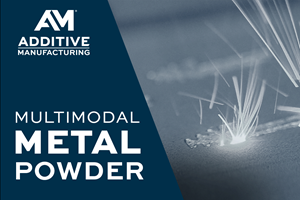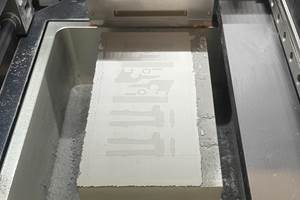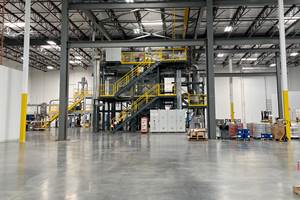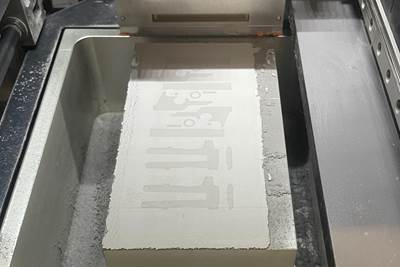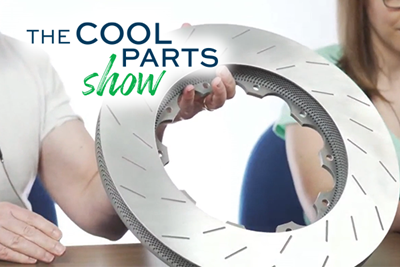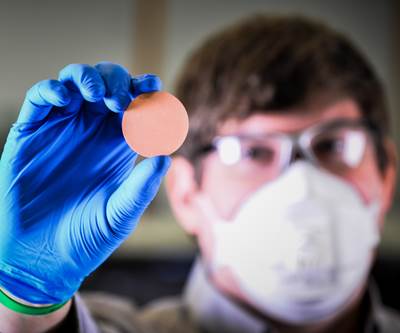Reusable, 3D Printed Copper Filter: The Cool Parts Show #28
In this episode of The Cool Parts Show, we learn how controlled porosity obtained through binder jetting can be applied to build metal filters capable of trapping — and even eliminating — virus particles.
Share
Porosity is typically a fault in metal 3D printing, but what if it could serve a purpose? The ExOne Company has found that controlled, intentional porosity can actually provide filtration, allowing water or air to pass through a printed part while trapping unwanted particulate.
In 2020, the company began to explore the use of binder jetting to manufacture reusable metal air filters designed as an alternative to disposable N-95 masks. Tweaking aspects of the binder jetting process allows for 3D printed filters with varying degrees of filtration, surface area and air flow. Patrick Dougherty, senior R&D engineer at ExOne, joins us for this episode, which was originally broadcast live on February 9, 2021, through the IMTS spark platform. | This episode of The Cool Parts Show brought to you by Carpenter Additive
The Cool Parts Show is a video series from Additive Manufacturing Media that explores the what, how and why of unusual 3D printed parts. Watch more here.
Have a cool part to share? Email us.
Links and resources
- ExOne Using Metal 3D Printing with Controlled Porosity for Reusable Filters in Response to Coronavirus Crisis
- AM 101: Binder Jetting
- Another example of controlled porosity, applied for mold venting
Transcript
Stephanie Hendrixson
Porosity in metal 3D printing is usually a bad thing, but not if you can control it. We have an example of intentional porosity for filtration in this episode of The Cool Parts Show. This episode was originally streamed live through the IMTS spark platform. Enjoy.
Peter Zelinski
The Cool Parts Show is brought to you by Carpenter Additive. The company's Athens, Alabama Emerging Technology Center is an end-to-end additive manufacturing production facility with everything from material development, to post processing under one roof, ready to help you with your next metal 3D printing job. Check them out at Carpenter Additive.com. Now back to the show. Hi there. I'm Pete Zelinski.
Stephanie Hendrixson
I'm Stephanie Hendrixson.
Peter Zelinski
Welcome to The Cool Parts Show live.
Stephanie Hendrixson
This is our third special live episode through IMTS spark. If you haven't joined us live before this is a lot like the regular show with the exception that our expert is going to be joining us here live very shortly.
Peter Zelinski
Stephanie we've got this bright, odd little disc.
Stephanie Hendrixson
This is today's cool part. This is a 3D printed copper filter, so it's all one piece and the filtration is built in.
Peter Zelinski
To filter what?
Stephanie Hendrixson
To be specific, this is an air filter. This was developed by The ExOne Company to filter out the coronavirus. ExOne was actually looking into 3D printing metal filters for water prior to the pandemic and they decided to see if they could take some of the lessons they've learned, and apply them to create a metal filter that could be reusable for respirator systems to protect against the coronavirus.
Peter Zelinski
Ok, so a couple pickups out of that. The coronavirus crisis and an innovation arising from that. That's the nature of crises right? They lead to changes in thinking, invention that has implications beyond the crisis. I'm excited to hear more about that. We know ExOne metal 3D printing technology. They're well known for binder jet, and I have to believe that somehow binder jet figured into the filtration that this is able to achieve. A filter right, so we usually think of a filter as a fiber, or a cloth. How can it be metal? Why metal?
Stephanie Hendrixson
Good question. During this coronavirus situation, we've gotten used to the image of the N95 mask, this woven thing that fits over your face and really that mask, the entire thing is the filter. Those masks work great, but the issue with them is they're not reusable. You can't really clean it, you can't put it into an autoclave, at a certain point that mask has met its usable life, and it's safest to just throw it away. The idea behind this filter was to develop something that would be reusable, and cleanable. Obviously this is not going to cover your entire face, so this would be sort of a filter cartridge that you would put into a respirator system. The way that they get to filtration is not by weaving fibers together, but by actually building porosity into the middle of this disc.
Peter Zelinski
You're answering what felt to me like a really obvious question, which is how do you breathe through a seemingly solid piece of metal? The answer is that it's not solid. There's porosity running all through this, and usually the lack of porosity is the bragging point of metal additive processes. We talk about how dense they are. You're kind of saying that the microscopic porosity here is good porosity. It's the characteristic that we're looking for.
Stephanie Hendrixson
Exactly, this is not a fully dense metal part, but that doesn't mean it's a faulty part. It's porous by design, and it is a controlled porosity.
Peter Zelinski
How do you control porosity? What do you do to a binder jet process to get exactly the filtration that you want?
Stephanie Hendrixson
A good question, but before we go there let's talk about binder jetting. Do you want to explain the process a little bit?
Peter Zelinski
I can do that. Binder jet is a metal additive manufacturing powder bed process, but it's the process that may have the most in common with printing the way we think of it, printing on paper. A binding agent is laid down using what looks like inkjet nozzles, a binding agent layer by layer binds together the metal powder into the shape desired, and it comes out of that process in a brittle state, a fragile state, called a green state. It goes from there to a sintering oven where at higher temperature, the metal particulate fuses and achieves the final compactness, hardness and metal properties to get a precise fully realized production part. It is metal additive manufacturing that does not involve melting and I have a feeling that the fact that there's never a liquid state is probably key to achieving and holding the porosity we're looking for.
Stephanie Hendrixson
Yeah and you asked how the binder jetting process is adapted to achieve this porosity, and there's a couple of different variables you can play with. Just to run through a couple, it is a powder-based process, and the size of the powder particles can have an effect, if you have larger pieces of powder, they're going to leave larger pores in between them. Smaller powder, finer powder, you get smaller pores, the way that you handle the powder has an effect, so some of these systems after they replenish the layer of powder before the binder drops, you can actually compact it. By either compressing it more, or compressing it less, you can influence the porosity. Then there's that sintering step that you alluded to. If you put this into your oven, your furnace, and maybe lower the temperature, or reduce the amount of time that it spends in there, you're going to end up with a less dense, more porous part. A couple of different ways that you can tweak the process to get to that controlled porosity.
Peter Zelinski
The result is a is a filter and as you've described there are these variables you can control within the binder jetting process to get you this porosity, and the result is you have this filter that could be sterilized and reused. This still looks like a solid metal part, can you really breathe through this?
Stephanie Hendrixson
That's been a real challenge with this project actually. If you've been following, you know the news around 3D printing and the coronavirus, you might have seen an earlier press release last year from ExOne with a filter that kind of looked like this, but it was more of a flat disc with lots of teeny tiny little pores in it. They found that design worked really well, and they were getting filtration that was actually exceeding the N95 standard, but you couldn't breathe through it. With this design, you have these kind of triangular holes, and they're basically funneling air into the area of tighter porosity. By increasing the surface area of the filter, you can get more airflow through, and you can actually breathe through this. I do want to mention that ExOne also sees a case for those other kinds of filters, not for respirator masks, but maybe for air handling systems like on a bus, in a plane, and in buildingsm— situations where you would be able to mechanically force the air through the filter, and you're not relying on somebody's lungs to move it.
Peter Zelinski
I get the engineering challenge involved here is getting porosity that is fine enough and tight enough that it can catch a virus, but then balancing that with enough surface area that a normal human with normal lung strength can draw air through this, and these triangular divots are a device for increasing the surface area. The porosity running through this is so fine that we can't see it. Is it the size of a virus?
Stephanie Hendrixson
Not necessarily. A virus filter doesn't necessarily have to have pores that are smaller than the thing it's trying to filter, but what it has to do is create opportunities for those particles to get trapped. The pores running through this filter may not necessarily be smaller than the coronavirus, but they're going to force the coronavirus through all these twists and turns and these passageways that are going to make it much more likely for that particle to get stuck on a wall somewhere and not make it all the way through.
Peter Zelinski
I get it. When you say filter, I imagine a strainer, but that's not right. It's not a strainer, it's a maze.
Stephanie Hendrixson
Exactly.
Peter Zelinski
Where is this at? Is this a real solution ready to go?
Stephanie Hendrixson
I think now would be a great time to bring in our experts. Let me introduce you to Patrick Dougherty. He is a senior R&D Engineer at the ExOne Company. Patrick, thanks for joining us.
Patrick Dougherty, The ExOne Company
Thank you so much for having me, Pete and Stephanie.
Stephanie Hendrixson
We have been talking about the development and making of this filter. We want to know where you're at with this, what's the status of this project?
Patrick Dougherty
This has been a pretty exciting and really fast-moving project from the start as you mentioned. We had a press release last year, and in a way I think we first approached the pandemic we kind of all thought we needed a turnkey solution right away. We pushed really hard to move quickly, but as you mentioned before it's been a challenge. We've been kind of moving forward on the R&D side as quick as we can to start optimizing the design, getting larger air flows, and working a lot with both people at the FDA, working with some government, some academia, and looking for partners to push this forward. I would say that right now, we're still in that developmental stage, but I think we've seen that this is a problem that probably isn't going away right now. We're really still trying to push this forward to get a solution that could be to market that will have, as you alluded to earlier, that magic mix of enough filtration, but enough airflow at the same time.
Peter Zelinski
Patrick, can we talk about the material for a sec? It's copper and I know that in metal 3D printing in general, copper presents challenges in laser-based processes where there's melting involved. There are some difficulties working with copper, does copper present a challenge or difficulty in binder jet?
Patrick Dougherty
Copper is a really interesting material. We've run into a couple that are like this. Whenever it packs in powder form it has this strange property where the green density that we get is at that point where the just binder and powder particles now is actually lower than the apparent density of the powder. Apparent density is generally how if you pour this powder, and for those who don't know, how's it going to pack just under its own weight. Copper has this phenomenon where it'll actually be less dense than if you just poured it into a vial and let it sit. That's very different than most of the powders that we work with where your green density is going to be somewhere between apparent and tap because of the compaction that we add. Normally that's a challenge that we are fighting for a lot of really unique techniques on our end that we've talked about before, like nanoparticles in the binder and things like that, but in this case, in this application, it actually helps us. It allows us even wider control over the porosity that you would see, and allows us to get to some really low density parts that still maintain strength where you can still handle them. That's definitely one of the happy accidents involved with this project and with copper that it's such a great antiviral material, but it actually lets us to get more porosity and better porous networks.
Peter Zelinski
You mentioned the antiviral properties, let's go there a little bit. This is a reusable filter and conceivably that means you would sterilize it between uses. Are you learning anything about what copper makes possible? Is it possible you just leave this out overnight, and just the copper alone kills the virus?
Patrick Dougherty
That's one of the things we like to bring to the table the most with this product, is that reuse, but also this ease of cleaning and sterilization where there's almost like a self-cleaning procedure that goes on with viral particles. There have been a number of articles published about copper from the New England Journal of Medicine, lots of studies on the news, I'm sure you've seen products that have come up like even some of the masks that have fiber reinforced copper in them. Those studies really all point to the fact that generally within four to six hours, you'll get up to and maybe even more now like a log-4 reduction in terms of the virus that would be touching the copper. It drastically pulls down that population of the virus to log-4 reduction in 99.9999%. For our cases we have done some testing that we haven't gotten a chance to do anything with real viral particles yet, but we've done some testing with surrogates where we've seen down to a log to production just within an hour, which is really encouraging of 99.99% reduction. What's unique about this is the porous nature of this product in general makes it a little hard to test. Imagine I'm putting a sample on there and I want to find out how much is left when I'm done, I have to be able to test that sample of what I put down again, and it's been challenging with this because it just soaks up so much that sample because of the porosity. We really think that we're going to have an even enhanced effect in that regard, because there's just so much surface area nested within this porosity for that virus to get trapped by and then subsequently die.
Stephanie Hendrixson
Talk a little bit more about the different design iterations that you went through. We know there were at least two different versions, but I think that's not everything that you considered. How did you end up with this design?
Patrick Dougherty
That's honestly a pretty cool story. We started it off with, as you mentioned, the press release before that people have probably seen of just a disc that was probably that big. It was it was good for filtration, we were getting up in that and 99% range. So 99% of particles were being stopped by the filter, but we had to push the pressures up to get the requisite air flows beyond what would be feasible by somebody, especially if you're working on your feet all day. We really had to up the surface area so that you can have more channels that could pull air through. The idea is that those pores are going to be the same, and it's still going to be a really long and twisty path from one end to the other. You can pull more air, but still trap just as many particles. We went through some iterations on our own in terms of just looking at increasing the size of the disk, but then we really wanted to get more clever about it.
What we did was we pulled in some of our collaborators at the University of Pittsburgh for their engineering school, and they actually put a big challenge out there to a senior design team to come up with what is a little bit of design for binder jet. What's the kind of design that's really going to give us a robust handleable part, and one that will survive the furnace, but also what's going to maximize our surface area. They pulled a lot from like heat exchanger design, and finding out a part that would start off with kind of like big pin arrays that would stick up. That was really our first big surface area change, it looked like it had a bunch of needles sticking out of the top, but it was pretty fragile. It was hard to handle, so we moved on to another type of design, and a couple of them that featured concentric bull's eyes. Imagine I had my circle, with a smaller circle inside that one, and another smaller circle inside of that. All of these basically sitting on a disc, and each of those is a millimeter thick porous wall that you pull the air through. Finally it came to this one, which really put in the best of high surface area, you can handle it much easier, and you don't have to worry about it nearly as much in the furnace in terms of distortion, slumping, or any type of cracking. I should note that they ended up winning their big senior capstone engineering program at Pitt. It was really exciting I think, hopefully for them as well, and we're glad that they can help us out and add some design expertise in that regard.
Peter Zelinski
There are applications beyond the respirator use that we're talking about. Right before we brought you on, Stephanie mentioned the possibility of air handling systems maybe in buildings, and in vehicles, can you talk a little bit about that? Maybe what those applications look like, and the way forward there that you see?
Patrick Dougherty
Absolutely, a couple months in it kind of clicked in lightbulb fashion that we're not getting as easy a path to the air flows that you could just put on a mask and breathe through easily. We thought that's obviously something we want to overcome in terms of bringing this to a filter that could be used for PPE, but there's this other avenue. If we could use these in an inline system an HVAC, and be able to essentially combine that with your standard HEPAA filter that will be used, but this would be an antiviral version of that and one that would be hopefully self-cleaning. You wouldn't have to take it out of the system nearly as often as you might with another type of filter. You can imagine the implications that would have for something like the transportation industry in terms of being able to use this on an airplane, a bus, or a subway, to large buildings like convention centers. One of the biggest bites we've gotten at this to get some early testing has been actually at Pitts facilities for some of their labs. You could imagine an array similar to the filters we have now, or they might be stacked in a sheet that's very similar to the filter you would put in your furnace at home. You would put that in series with the other one, and this will be something that would, in addition to helping filter some of the other particles out as well, actually end up being an antiviral filter that would kill coronavirus particles for that. That is another avenue that we're excited about because we can use the building's system to push the airflow through, and we can leverage a much bigger surface area that you couldn't wear on your face or it would be pulling your head down all day. There's a lot of benefits there for us and it's a much more near-term application we believe than necessarily having to push the whole way to PPE.
Peter Zelinski
I think I've got this.
Stephanie Hendrixson
All right, take it away.
Peter Zelinski
This is a filter enabled by 3D printing. A filter we usually think of as made of cloth and fiber. This is a reusable metal filter enabled by binder jetting made copper, antiviral metal, and using binder jets solid state 3D printing capabilities to control the porosity all the way through the process. Oftentimes with metal parts porosity isn't what you want, you want as near to complete density as you can get, but in this case porosity is an engineering advantage getting just the right pore sizes to enable this to filter out coronavirus. The initial application was for respirators with the idea being to get enough surface area for airflow to allow a human being, human lungs to draw air through the porosity that is catching the virus. Other applications that they've found as they imagine the possibilities for this reusable filter are industrial in vehicles, in systems where pressure is driving the air through. This looks like a solid metal part, it is not. There is microscopic porosity all through here intricate, complex winding paths all through this seemingly solid metal that capture the virus as it goes through. Studies are being prepared to validate the question of whether the antiviral properties of copper might be enough to let the virus die, and maybe no interim sterilizing step would even be needed.
Stephanie Hendrixson
Great recap, I think we should bring Patrick back and take some audience questions.
Peter Zelinski
We've talked a little about how the fineness of the powder affects the porosity, but I understand ExOne has been looking at adding nanoparticles of material into the binder itself. Alluding to what you mentioned earlier Patrick, can you tell us more about nanoparticles?
Patrick Dougherty
We've held some patents on nano particulates and have been including them into the binders for many years now. Since some of the early technology that we put forth, we've started to make more advancements in that sector. One of the things that I actually gave a webinar that we presented on nano fuses, which is our version of the ExOne binder that has a functionality in it in terms of working with a nanoparticle system that will be tailored for that specific material. In the case of copper, what we've looked at and presented there was that we were actually able to increase density over non particulate, nano fuse assisted copper, by up to 4%. For us in terms of what we presented there, was the difference between 90% and 94% for copper, or 92% and 96% for our best case, and that was really exciting. As far as we know, that's as far as people have gotten with binder jet copper. For other scenarios the nanoparticles have lots of different functional additives. It could be something that enhances from a sintering a perspective. If you have a difficult to densify material that's known to have sintering aids that will help the particles to fuse together, you can use the nanoparticles so that you don't have to worry about mixing it into a powder where you just have to essentially cross your fingers that the particles remain right where you need them. They get lodged in the interstitial sites between particles, but you can just deliver them right there so that they are literally put on by the binder to the particles where you need them. That's some of the most exciting aspects of that for this project. There's even the fact that these nanoparticles do have a tendency to increase surface area. This is relatively new in terms of the filter project, but there's a good chance that it'll creep in here as well and we'll start using it when it comes to these porous metal filters.
Peter Zelinski
One other question came in, Patrick. It's really simple and I love this because as we think about production for a product like this, how do you inspect these filters?
Patrick Dougherty
That's a really good question. One of the things we've looked at so far has been CT. One of the challenges of that is the size of the part, and one of the things we've been trying to do the best with is make it very similar to how you do in other techniques. We'll do a witness coupon or something that will include in the build that we'll be able to use a micro CT on to actually examine what's the porosity like? What does it look like in terms of the connectivity? You can actually track the tortuosity, so to speak, of these paths as they wind through. When it comes to looking at these down the road, we're trying to figure out a couple of nondestructive techniques that would be very similar to that, but capable of picking up some of the organic matter because for us, that's one of the big open questions in terms of how often do we have to clean these? One thing you can do is just track the airflow that you're pulling, right, or you can start to tell because the particles on the inside should be dead, even through autoclaving. You want to be able to see at what point do I have to clean it just to remove all the organic particles. Doing airflow tests, even doing weight, mass loss, and type of experiments is something we can do now but that's one aspect we'd like to improve upon in terms of really being able to see inside there. Not just look at the pores, but what's in the pores.
Peter Zelinski
That's our questions and my word for the day is tortuosity.
Stephanie Hendrixson
Thanks so much for joining us, Patrick.
Patrick Dougherty
Thank you so much for having me guys. I really appreciate it.
Peter Zelinski
Thanks Patrick and thank all of you who are tuning in live. Thanks for watching us. To see more episodes of the show go to TheCoolPartsShow.com.
Stephanie Hendrixson
If you have a cool part that you'd like to tell us about, you can email us at CoolParts@additivemanufacturing.media. Thanks for watching.
Peter Zelinski
Thank you to our sponsor Carpenter Additive. Listen to additive manufacturing podcasts, attend webinars, and learn more at Carpenter Additive.com
Related Content
Tritone, DSH Technologies Launch Outsource Sintering Furnace-Access Program
Through the Furnace-Access program, Tritone customers will have immediate access to Elnik sintering furnaces and metallurgy expertise with no upfront capital investment or additional staffing required.
Read MoreVideo: Multimodal Powders for Metal 3D Printing
Rather than uniform particle diameters, multimodal powders combine particles of different sizes. In this video, how and why Uniformity Labs produces multimodal metal powders for additive manufacturing.
Read MoreAM 101: What Is Binder Jetting? (Includes Video)
Binder jetting requires no support structures, is accurate and repeatable, and is said to eliminate dimensional distortion problems common in some high-heat 3D technologies. Here is a look at how binder jetting works and its benefits for additive manufacturing.
Read MoreMultimodal Powders Bring Uniform Layers, Downstream Benefits for Metal Additive Manufacturing
A blend of particle sizes is the key to Uniformity Labs’ powders for 3D printing. The multimodal materials make greater use of the output from gas atomization while bringing productivity advantages to laser powder bed fusion and, increasingly, binder jetting.
Read MoreRead Next
AM 101: What Is Binder Jetting? (Includes Video)
Binder jetting requires no support structures, is accurate and repeatable, and is said to eliminate dimensional distortion problems common in some high-heat 3D technologies. Here is a look at how binder jetting works and its benefits for additive manufacturing.
Read MoreLighter, Better-Performing Brake Rotor From 3D Printing: The Cool Parts Show #27
Additive manufacturing with an aluminum/ceramic composite enables a brake rotor with one-third the weight and five times the heat transfer of a typical rotor. We talk to the inventor on this episode of The Cool Parts Show.
Read MoreExOne Using Metal 3D Printing with Controlled Porosity for Reusable Filters in Response to Coronavirus Crisis
Collaboration with University of Pittsburgh applies binder jet to produce an alternative to disposable masks that are in short supply.
Read More
.jpg;width=70;height=70;mode=crop)





